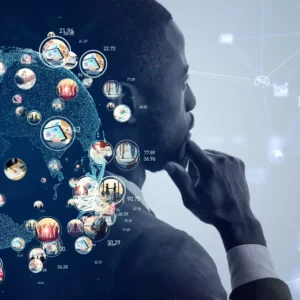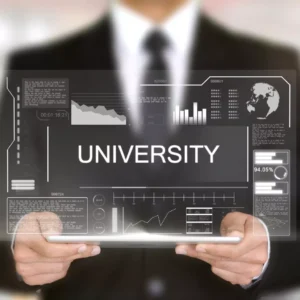
Digital Transformation in Education Unlocking Efficiency
5 Areas Where Process Automation Takes the Lead
The impact of digital transformation in education is truly revolutionary with the power of Intelligent Process Automation.
Technology revolutionises the education industry, specifically Intelligent Process Automation (IPA). Schools can allocate more resources to improve education quality with streamlined administrative tasks.
IPA has the power to create a more enriching and engaging learning experience for students, marking a new era of digital education.
Table of Contents

Arindam Roy
An Automation Consultant with 25+ years of IT Experience
Automation in the Education Sector
Attention educators! The burdensome and time-consuming tasks hindering your productivity may be a thing of the past. Say goodbye to manual data entry, record-keeping, and report generation that consume your energy and resources.
With the assistance of IPA, educational institutions can streamline these tasks, allowing you to focus on making a difference in your students’ lives.
For instance, take the student enrolment process.
You no longer have to worry about manually entering student information into various systems, which may lead to errors and delays. IPA automates data entry, ensuring efficient and accurate enrolment, freeing up your valuable time to focus on your student’s success.
However, the benefits of IPA don’t stop there. Think of the time and effort saved by automatically grading multiple-choice tests and assignments, providing prompt feedback to students, and freeing up your valuable time to enhance the learning experience.
IPA enables faster feedback loops and improves the overall learning experience for everyone involved. Let us embrace the power of technology and revolutionise the education sector together!
Digital Transformation in Education
IPA’s digital transformation has made technology integral to the learning experience. IPA automates administrative tasks, digitises workflows, and enhances data management, making it a game changer.
A remarkable example of digital transformation is the automation of attendance tracking, replacing manual paper registers. IPA enables schools to use biometric systems or barcode scanners to track attendance, ensuring accuracy and reducing administrative burdens.
But that’s not all! IPA can also revolutionise the creation and distribution of reports. Automated generation and distribution of digital reports, including progress reports and report cards, can eliminate the need for manual report creation.
This saves valuable time for teachers and administrators, enabling them to focus on personalised interactions with students and parents. It’s time to embrace the digital age and let IPA transform our learning and teaching!
Student Data Management
Enter Mr Adams, the tech-savvy computer teacher who proposed an automation solution. Sceptical at first, the staff embraced the change, and soon, their school transformed. Automation made data entry a breeze, and errors were reduced dramatically.
But challenges loomed. Hackers attempted breaches, and fears arose about data security. Mr Adams spearheaded a robust cybersecurity system, thwarting any threats.
As the system matured, the benefits flourished. Teachers accessed real-time data to tailor lessons, and parents received insightful progress reports. Administrators streamlined tasks, fostering a dynamic learning environment.
Hillside High School had become a pioneer. Automation has conquered the challenges, revolutionizing student data management and propelling them into a bright, tech-driven future.
Timetable Management
Enter Dr Carter, the brilliant tech professor. He tirelessly worked to implement an automated timetable system. But challenges awaited – integrating various departments’ needs and ensuring fairness
. Undeterred, Dr Carter collaborated with teachers, understanding their preferences and constraints. He fine-tuned the algorithm to optimize class times and minimize conflicts.
When the system launched, magic happened. The timetable was seamless, and everyone rejoiced. Teachers found more time for lesson planning, and students had well-balanced schedules.
Yet, a few sceptics loomed. Some feared a rigid system. Dr Carter addressed this by adding flexibility for adjustments.
Soon, Maplebrook Academy became an example of streamlined efficiency. Automation had triumphed, elevating education through better timetable management, leaving everyone thrilled for a brighter, organized future.
Library Management
Enter Alex, the tech-savvy student and coding genius. Armed with passion, Alex embarked on creating a cutting-edge library management system. However, challenges arose when accessing the extensive book database and ensuring seamless integration with the checkout process.
With determination, Alex and the librarians collaborated, carefully mapping out requirements. The system began to take shape and soon roared to life.
As the automated library system launched, magic unfolded. Students scanned books with ease, instantly knowing their availability. Librarians now focus on curating resources instead of managing chaos.
Brooksville witnessed a reading renaissance! Students immersed themselves in books, and a newfound love for reading flourished. Automation had transformed the library into a literary wonderland, proving that the future of education rested in innovation and efficiency.
Student Support Services
Emily faced challenges, including integrating the university’s vast student data and ensuring data privacy. Undeterred, she collaborated with SSS staff to understand their needs and designed a comprehensive system that streamlined student appointments, academic counselling, and resources.
The automated SSS platform launched with excitement and trepidation. Yet, the benefits were undeniable. Students could book appointments effortlessly, and counsellors had real-time insights to tailor support.
As word spread, more students sought SSS assistance, but the system handled it seamlessly. Emily’s creation became a game-changer, allowing the SSS team to focus on personalized care and uplifting students.
Valleybrook thrived as students excelled, empowered by efficient support. Emily’s automation prowess had transformed the university, proving that, when harnessed thoughtfully, technology could elevate education to extraordinary heights.
Exam Management
Meet Ryan, a tech enthusiast and top student. He proposed an automated examination management system for the administration. However, challenges loomed—ensuring a secure exam environment and preventing cheating.
Determined, Ryan collaborated with teachers and programmers to develop an innovative online platform. The system featured encrypted tests, randomized questions, and facial recognition to verify students’ identities.
As the first automated exams approached, excitement and nervousness filled the air. The system surpassed expectations! Grading was instantaneous, and results were accessible within hours.
Oakridge Academy celebrated its success! Automation has revolutionized examinations, reducing stress for students and teachers alike. Ryan’s vision had transformed education, proving that embracing technology responsibly could lead to a brighter, more efficient future.
Conclusion
The education industry has the potential to transform itself by embracing the power of automation. With the help of Intelligent Process Automation (IPA), schools can streamline time-consuming administrative tasks and pave the way for a more digitally advanced learning experience.
However, it’s important to note that implementing IPA requires careful planning, stakeholder cooperation, and a strong focus on confidentiality and security matters.
Educational institutions must invest in the necessary infrastructure, training, and support systems to transition to IPA-powered processes seamlessly. As the world continues to evolve, the education sector must keep up with these changes by embracing digital transformation and IPA.
By doing so, schools can boost their efficiency, effectiveness, and engagement levels. By simplifying administrative work, educators can focus on their crucial task of guiding and encouraging the young minds of tomorrow.
Related Articles
- Beyond Books: AI in Shaping Modern Curricula
- AI in Educational RND: Pioneering Paths
- Tailored Teachings: AI in Support Need Education
- Smart Schools: AI in Educational Management
- Intelligent Intake: AI in College Admissions
- Never Stop Learning: AI’s Boost in Adult Education
- Digital Desks: AI’s Footprint in Modern Classrooms
- Virtual Varsity: AI in E-Learning Platforms
- Reimagining Rules: AI’s Influence on Education Policy
- Smart Choices: AI in Global Education Counselling
- AI in language learning apps: Chatbots to Culture
- AI-Driven Tutoring Platforms: 24/7 Tutors
- Play to Learn: AI Transforming Educational Games
- Scoring with Systems: AI in Exam Prep
- Tiny Tots, Big Tech: AI’s Role in Preschool Education
- Classroom Companions: AI Tools for K-12 Education
- AI-driven EdTech Solutions: Revolutionizing EdTech Investment and Engagement
- Learning Never Stops: AI’s Impact on Continuous Education
- Skill & Scale: AI in Vocational and Technical Training
- Campus to Computer: AI in Virtual Learning in Higher Education
- Other Articles on AI Usage in Education
- Other Articles on AI usage in other industries





















